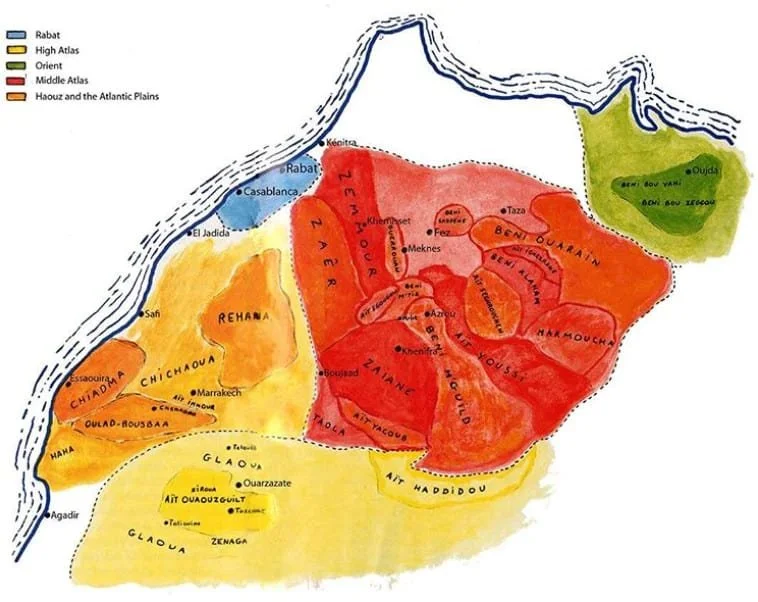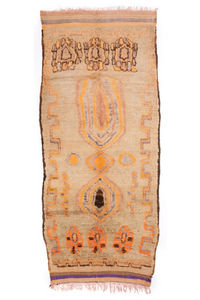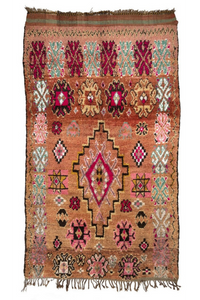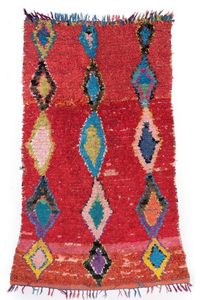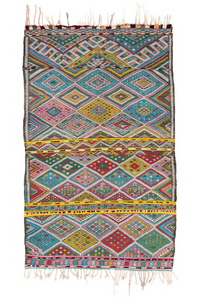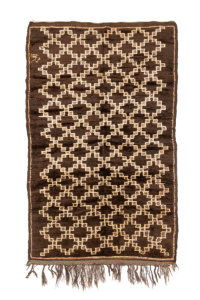Regions and Types
The rich cultural diversity in Morocco can be seen in the various types of rugs.
Berber rugs come in different shapes, colours and thicknesses. Each region and tribe has its own specific rug, influenced by culture, climate and natural environment. Recognizable by their strict use of colour, patterns and symbolism referring to for example social class, status and background. The design repertoire is also driven by the weaver’s own collective knowledge and her individual interpretation. The rugs are therefore also a reflection of the weaver's stages of life, her family, culture and environment and each rug is woven as a form of artistic reflection.
Azilal
The Azilal region, located between the north of the High Atlas and the south of the Middle Atlas, is known for its unique and vibrant geometric designs. Azilal rugs are single knotted, allowing for intricate details and artistic expression. These rugs feature patterns reminiscent of the graphic black and cream Beni Ourain rugs but with more vibrant colours similar to the Boucherouite rugs. Each colour used in the Azilal rugs holds special significance in the Amazigh culture, and the background is usually a light cream colour.
Traditionally, these rugs were made by the matriarch of the family and passed down from generation to generation, with each rug containing an intricate combination of symbols that tell the story of the maker, such as symbols for love, birth, protection, and marriage.
The rugs were originally used to provide warmth during cold Atlas weather and could take weeks or even months to complete, reflecting the personal and unique fingerprint of the family that it belonged to. Azilal rugs originated from the "Azilal" nomads in the High Atlas mountains and are recognized by their light pile and small size, which made them easy to transport.
Unlike other Moroccan rugs, Azilal rugs have a certain freedom in their designs, as each nomadic family creates their own unique patterns, colours, and techniques. The base of an Azilal rug is often a light cream or white colour, and the natural wool is woven with vibrant coloured wool, tinted with regional flora, giving them an innocent allure that makes them stand out from other Moroccan rugs.
Boujad
The Boujad rugs are made in the middle Atlas by Arab tribes and Arabised Berber tribes, and they are named after the town of Boujad at the foothills of the Middle Atlas. These rugs are known for their warm colours, which can bring a cosy atmosphere to any room. Typically, Boujad rugs feature shades of pink, red, orange, and purple, with beautiful motifs made from lozenges, lines, and other shapes. The designs are highly individual, often containing motifs that refer to Amazigh motifs, checkerboards, and abstract patterns. Older vintage rugs can have washed but warm pastel tones, and the rugs usually have a low pile.
Originating from the middle of Morocco, nearby the city of Béni-Mellal, Boujad rugs seem to be less concerned with the rules of order and balance, featuring patterns that consist of floating geometric shapes, squares, rectangles, or diamonds, but with slightly distorted forms that create a unique image. These rugs are made with soft wool, and their colours are often created by natural flora such as flowers, berries, and leaves, resulting in the recognizable warm red colour palettes that combine magenta, orange, and pink hues with some elements of lighter pink. The patterns in Boujad rugs reflect the whim of the weavers, making them a piece full of identity and heritage.
Boucherouite
Boucherouite rugs are a unique type of rug that are made from used fabrics and are not associated with any specific region or tribe. The word "Boucherouite" is derived from the Arab word 'Bu Sherwit', which means rag, and the tradition of making these rugs arose during times of scarcity and famine when people knotted together old fabrics. Over time, it gained acceptance among even the most remote tribes such as the Ourika, making it hard to define its origins. Boucherouite rugs often have very geometrical designs due to the limitations of the material.
They are also eco-friendly and heavy, but much easier to wash than standard woollen rugs. The rugs represent a free expressive art form, as the creative Amazigh craftswomen combine patterns in a free-style with a mix of colourful materials and ideas, resulting in bold, contemporary textures and vibrant aesthetics. They also tell the story of a transforming community since the 1950s and 60s, adapting from a nomadic existence as sheepherders to an increasingly urban lifestyle, where wool was no longer the obvious choice, and the scarcity of resources in the cities made it necessary to find alternatives.
Beni Ouarain
Beni Ourain rugs are one of the most well-known rug types in the world, originating from a group of 17 individual tribes in the Middle Atlas. These tribes settled in Jebel Bouiblane in the 9th century A.D. and excelled in selecting the best soft and silky wool, which was used to insulate the floors of their tents from the glacial winters of the Atlas. The pile of the rug varies from 25 to 50mm long, and the rug with its neutral tones and elegant, minimalistic geometry fits in almost every interior.
The rugs are traditionally much longer than they are wide, since they were originally used to cover the entire floor of rectangular tents and present-day Amazigh houses. The geometric motifs on the rugs are built up from lines in crossed and diamond shapes, with the cross representing a male motif that is believed to protect from evil energies, and the diamond shapes representing female qualities and fertility. The wool used for the Beni Ourain remains undyed, and is made from black, brown, and white sheep, with the white sheep providing an ivory background for each rug.
Despite not being as colourful and outspoken as other Amazigh rugs, the beauty of the Beni Ourain lies in the hidden details and imperfections that give the rug depth and character. Differences in colour, varying thicknesses of lines, and asymmetric patterns reveal the personality of the maker, making it almost impossible to copy these imperfections with modern machines. The Beni Ouarain has been ubiquitous in the West since the mid-19th century, mostly due to their popularity with well-known architects such as Frank Lloyd Wright. Almost a quarter of Morocco’s sheep population comes from this region, and they are considered to have some of the best wool quality.
Kilim
Kilim is a word of Turkish origin that refers to a pileless and flatwoven textile that shares a common heritage across Turkey, the Balkans, and the Arab world. Kilims are ideal for use in hot climates because of their lightweight weave, and they are popular among Moroccan tribal weavers. The women of the Atlas Mountains make stunning kilims that use beautiful colours and designs.
These rugs are durable, resistant to high sun exposure, and perfect for both indoor and outdoor use. Kilims are often decorated with embroidery or sequins, and the designs are typically geometric, made by interweaving variously coloured wefts and warps. They are used for many purposes, including as floor and wall coverings, extra insulation against the cold, tent doors, prayer rugs, and more. Kilims are also often included in a bride's trousseau in many tribes.
Marmoucha
Marmoucha rugs, hailing from the Eastern Middle Atlas mountains close to Fes, are traditionally thick and high-piled carpets featuring distinct diamond patterns. These rugs were originally used as bedding carpets due to the harsh winters in the region.
Soft, natural colours such as white, light grey, and brown are typical of Marmoucha rugs. Interestingly, the Marmoucha tribe shares some design similarities with their neighbours, the Beni Ouarain. It is worth noting that almost a quarter of Morocco's sheep population comes from the Marmoucha region, known for its high-quality wool.
Taznakht
In the southern part of Morocco, near the pre-Sahara, lies the region of Taznakht, which is famous for producing high-quality rugs. These rugs are renowned for their use of fine wool and intricate knotting, as well as their smaller sizes and vivid colour palettes that often feature earthy reds and yellows.
Taznakht is known for having the highest concentration of craftspeople in all of Africa, with almost every household having a loom and every female being skilled in knotting and weaving rugs. The weavers in Taznakht still rely on natural resources such as pomegranate, henna, plants, roots, flowers, dates, and bark cloth to dye their wool, keeping the tradition of natural dyeing very much alive in this region.
Ait Ouaouzguit
Ait Ouaouzguite rugs are a special kind of Berber rug made by the tribes of Ait Ouaouzguite confederations. They use silky, high-quality wool that they source from their own herd, giving their rugs a distinctive feel.
These rugs come to life with vivid and bright colours, bringing joy to any room. One of the things that sets Ait Ouaouzguite rugs apart is the intricate storytelling woven into their design, often featuring strong traditional stories and cultural symbolism. Additionally, the high-quality wool used in these rugs is known to reflect light beautifully, creating a lovely sheen.
Handira (Wedding Blankets)
When a Moroccan Berber woman from the Middle Atlas Mountains gets married, female family members from her tribe make a wedding blanket known as a Handira for her. She wears the Handira during the wedding ceremony and wraps this around her shoulders. It takes many weeks to produce the wedding blanket. The sheep must first be shaved. The wool is then washed and spun to yarn before they can start weaving. During the making process, rituals are performed for a blessed and happy marriage and the future bride is provided with marital advice. The sequins are carefully sewn on for decoration and to ward off evil spirits. The beautiful Handira is steeped in feminine blessings and fertility. Today the wedding blanket works as a plaid over a bed or couch in a modern home.


